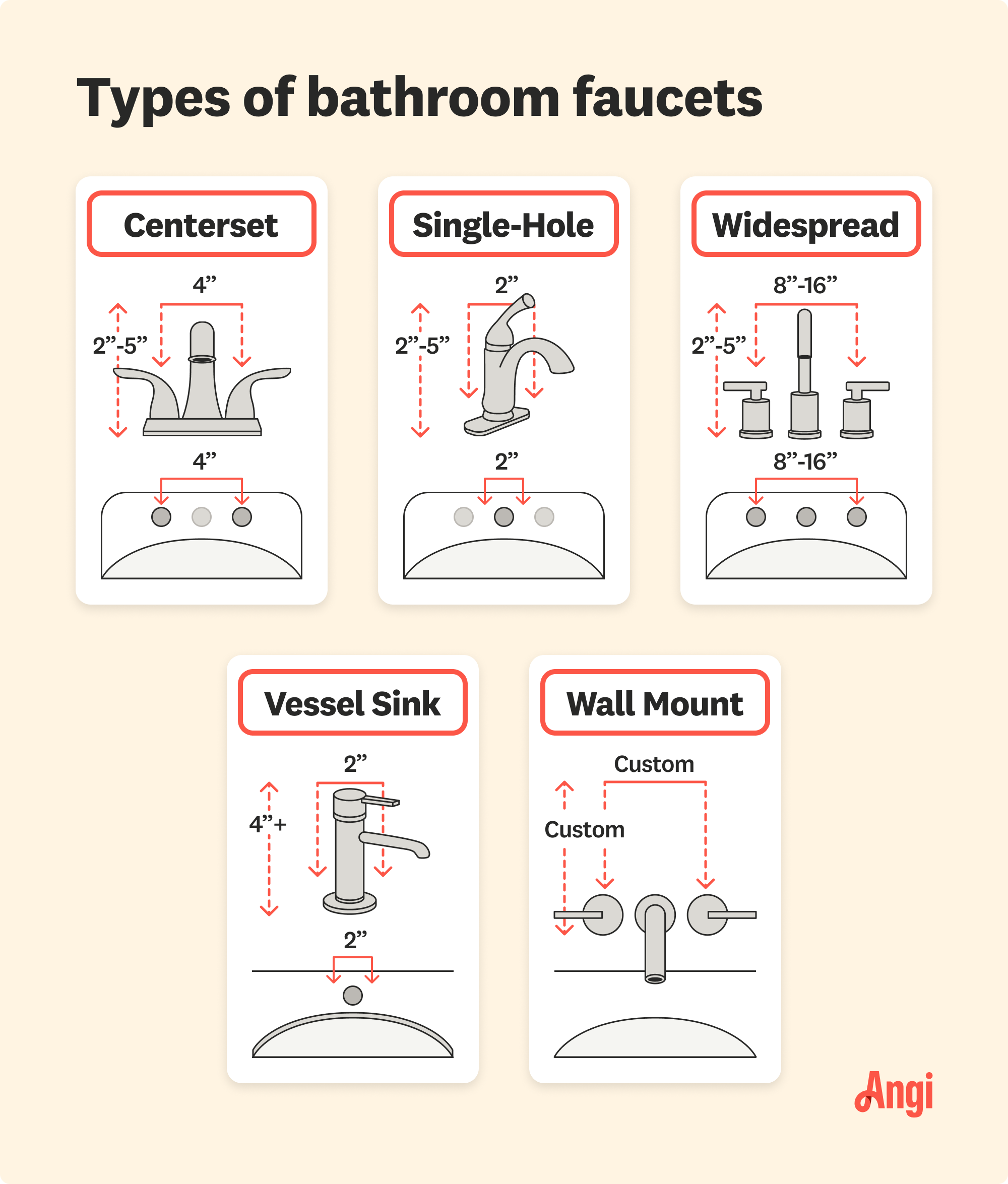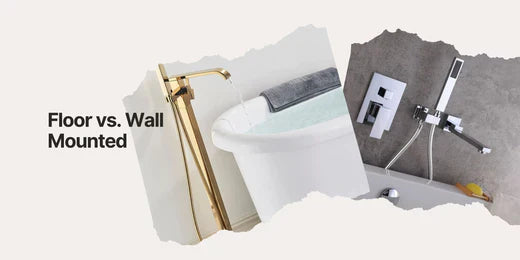18 min read
When it comes to choosing the perfect faucet, one detail often gets overlooked: wall depth. You might think it’s a small technical point, but it can make a big difference in how your faucet fits and functions.
Imagine installing a faucet only to find it doesn’t reach your sink properly or looks awkward against your wall. That’s frustrating—and avoidable. You’ll discover why wall-depth matters, how to measure it, and what to consider before making your purchase. By the end, you’ll feel confident making a choice that fits your space perfectly and looks great too.
Keep reading to avoid costly mistakes and get the faucet setup you deserve.

Credit: www.kohler.com
Choosing The Right Wall Depth
Choosing the right wall depth is important for faucet installation. It helps ensure the faucet fits well and works properly.
Wall depth affects how the faucet connects to water lines and how it looks on the wall.
Measuring Wall Thickness Accurately
Measure the wall thickness where the faucet will go. Use a tape measure or caliper for best results.
Check the thickness in several places to find an average. Walls may vary in thickness.
- Remove any wall coverings like tiles or panels
- Measure from the finished wall surface to the inner wall frame
- Record multiple measurements for accuracy
Standard Wall Depths For Faucets
Most faucets fit walls between 1 and 2 inches thick. This range covers many common wall types.
Standard wall depths help plumbers select the right faucet length and connectors.
| Wall Type | Typical Thickness | Faucet Compatibility |
|---|---|---|
| Drywall | 0.5 to 0.75 inch | Standard faucets fit well |
| Tile over drywall | 0.75 to 1 inch | May need slightly longer faucet parts |
| Concrete or brick | 1.5 to 2 inches | Requires deep-mount faucets |
Adjusting For Non-standard Walls
Some walls are thicker or thinner than standard sizes. You must adjust the faucet setup for these walls.
Use extension pieces or shorter connectors to fit the wall thickness accurately.
- Thick walls may need faucet extensions or custom parts
- Thin walls may require adapters or shorter mounting hardware
- Always measure before buying faucet parts
- Consult a plumber if unsure about adjustments

Credit: www.angi.com
Types Of Faucets And Their Depth Needs
Choosing the right faucet means understanding how deep it needs to fit into the wall or deck. Different faucet types require different wall depths for proper installation.
This guide explains depth needs for common faucet types. It helps you plan your bathroom or kitchen setup correctly.
Single-hole Vs. Wall-mounted Faucets
Single-hole faucets usually install on the sink or countertop. They need less wall depth because the plumbing runs below the deck.
Wall-mounted faucets require more wall depth. Pipes and valves sit inside the wall, so space must allow for these parts.
- Single-hole faucets need shallow wall depth
- Wall-mounted faucets require deeper wall cavities
- Wall-mounted models need easy access for plumbing repairs
Deck-mounted Faucets And Wall Compatibility
Deck-mounted faucets attach directly to the sink or counter. They do not need wall space for installation.
Walls behind deck-mounted faucets must still allow room for water supply lines. These lines usually run below the deck or behind the wall.
- Deck-mounted faucets need deck thickness to fit mounting hardware
- Water supply lines run behind or below deck, not inside wall depth
- Check wall space for plumbing access near the faucet
Specialty Faucets And Custom Fits
Specialty faucets, like pot fillers or commercial units, often need unique wall depths. These faucets may require extra space for large valves or longer pipes.
Custom installations must measure wall depth carefully. Builders may need to add space or use special fittings to ensure proper function.
- Pot fillers need deep wall space for folding arms
- Commercial faucets may need larger valves inside walls
- Custom fittings can adjust to limited wall depth
Installation Challenges With Wall Depth
Installing faucets on walls requires careful attention to wall depth. The depth can affect how the faucet fits and works. Too shallow or too deep walls can cause problems during installation.
Understanding these challenges helps avoid leaks, poor alignment, and damage. Different wall depths need different solutions to ensure a secure and functional faucet setup.
Dealing With Shallow Walls
Shallow walls do not have enough space for faucet parts. Pipes and connectors may stick out or not fit properly. This can cause leaks or damage to the wall.
Installers must use compact faucet models or special mounting brackets. Careful measurement before installation is important to avoid problems.
- Choose faucets with short connection pipes
- Use mounting plates to add support
- Seal all gaps to prevent water leaks
Handling Deep Wall Cavities
Deep walls create extra space behind faucets. This space can cause pipes to be hard to reach or secure. It may also lead to unstable faucet installation.
Use extension pieces or adjustable fittings to fill the cavity. Make sure the faucet is tightly fixed to avoid movement or leaks over time.
- Install pipe extensions to fill deep cavities
- Use adjustable mounting hardware
- Check faucet stability after installation
Solutions For Uneven Wall Surfaces
Uneven walls make faucet installation tricky. Gaps can form between the faucet base and wall. This can cause leaks and reduce the faucet’s lifespan.
Use mounting plates or shims to level the surface. Apply waterproof sealant to fill gaps and protect against water damage.
- Use shims to even out small gaps
- Install mounting plates for better support
- Seal all edges with waterproof caulk

Credit: acedecorbath.com
Tools And Techniques For Accurate Installation
Installing faucets correctly needs careful measuring and the right tools. Wall depth is important to ensure a secure fit.
This guide covers tools and techniques for accurate faucet installation. It helps avoid leaks and loose fittings.
Using Depth Gauges And Measuring Tools
Depth gauges help measure the wall thickness where the faucet will go. Accurate measurement prevents fitting problems.
Use a tape measure or caliper for precise readings. Mark the measurement before drilling or mounting the faucet.
- Use a depth gauge to check wall thickness
- Measure twice to avoid mistakes
- Mark the wall clearly before installation
- Use a caliper for precise depth measurement
Adjustable Mounting Hardware
Adjustable mounting hardware helps fit faucets on walls of different thicknesses. It allows fine tuning during installation.
Choose mounting brackets or screws that can extend or retract. This flexibility makes the faucet stable and well aligned.
- Select hardware with adjustable length
- Tighten screws evenly for balance
- Check faucet alignment after mounting
- Use washers to fill small gaps
Sealing And Waterproofing Tips
Proper sealing stops water leaks behind the wall. Use waterproof materials to protect the structure.
Apply plumber’s putty or silicone sealant around faucet edges. Make sure the seal covers all gaps.
- Clean surfaces before sealing
- Use silicone sealant for waterproofing
- Apply sealant evenly around edges
- Allow sealant to dry fully before use
Common Mistakes To Avoid
Choosing the right wall depth for faucets is important. Many people make mistakes that cause problems later.
Knowing what to avoid can save time and money. It helps your faucet work well and look good.
Ignoring Manufacturer Specifications
Each faucet has specific depth requirements. Ignoring these can cause leaks or improper fit.
Manufacturers provide measurements for a reason. Follow their guides to avoid damage and extra work.
- Check the recommended wall depth before installation
- Use the tools suggested by the manufacturer
- Don’t guess or assume the faucet will fit
Overlooking Plumbing Connections
Plumbing lines need enough space inside the wall. Overlooking this can make connections tight or impossible.
Make sure pipes and fittings fit well behind the wall. This prevents leaks and reduces repair needs.
- Measure pipe size and location before cutting the wall
- Allow extra room for fittings and valves
- Plan for easy access to plumbing for future repairs
Neglecting Wall Material Impact
Wall materials affect how deep you can install a faucet. Hard walls like concrete need special tools.
Soft walls like drywall may need extra support. Ignoring this can cause instability or damage.
- Know the wall type before planning faucet depth
- Use anchors or braces for soft walls
- Consider professional help for tough materials
Maintenance And Future Adjustments
Choosing the right wall depth for faucets helps with easy maintenance. It also makes future changes simpler.
This guide covers how to access faucets behind walls and adjust for changes over time.
Accessing Faucets Behind Walls
Faucets placed inside walls need space for repairs. A wall depth that allows access saves time and money.
Plan for an access panel or removable wall section near the faucet area. This helps fix leaks or replace parts.
- Leave enough space behind the faucet for tools
- Install removable panels for quick entry
- Keep plumbing details documented for easy locating
Adjusting For Wall Settling Or Renovations
Walls may shift or settle over time. This can change the faucet’s position inside the wall.
Allow some extra depth to adjust the faucet during repairs or remodeling. This prevents costly re-plumbing.
- Choose wall depth with some extra space
- Use adjustable faucet fittings if possible
- Check faucet alignment after major renovations
Extending Faucet Lifespan With Proper Fit
A faucet that fits well inside the wall lasts longer. Proper fit reduces stress on pipes and connections.
Make sure the faucet is flush with the finished wall surface. This prevents water damage and wear.
- Measure wall depth before installing the faucet
- Use correct mounting hardware for stability
- Keep faucet parts accessible for future maintenance
Frequently Asked Questions
What Is Wall-depth In Faucet Installation?
Wall-depth refers to the thickness of the wall where the faucet is installed. It affects the faucet’s reach and mounting options. Proper measurement ensures the faucet fits securely and functions well without leaks or gaps.
Why Is Wall-depth Important For Faucets?
Wall-depth impacts faucet stability and water flow efficiency. Incorrect depth can cause leaks or improper water pressure. It ensures the faucet aligns with plumbing and countertop surfaces for optimal performance.
How To Measure Wall-depth For Faucets Accurately?
Use a tape measure from the finished wall surface to the plumbing connection point. Measure precisely to avoid installation issues. Accurate measurement helps select faucets designed to fit your wall’s thickness.
Can Improper Wall-depth Damage Faucets?
Yes, an incorrect wall-depth can strain faucet components. It may cause leaks, loose fittings, or water flow problems. Ensuring the right depth prevents damage and prolongs faucet lifespan.
Conclusion
Choosing the right wall-depth for faucets is crucial. It ensures smooth installation. Proper depth avoids future plumbing issues. It also enhances the faucet’s functionality. Consider all factors before deciding on wall-depth. Measure carefully. Consult experts if needed. A little planning goes a long way.
This can save time and money in the future. Remember, every detail matters. Make informed choices for long-lasting benefits. Your home deserves the best setup. Keep these tips in mind. You’ll enjoy a hassle-free experience. Happy renovating!

